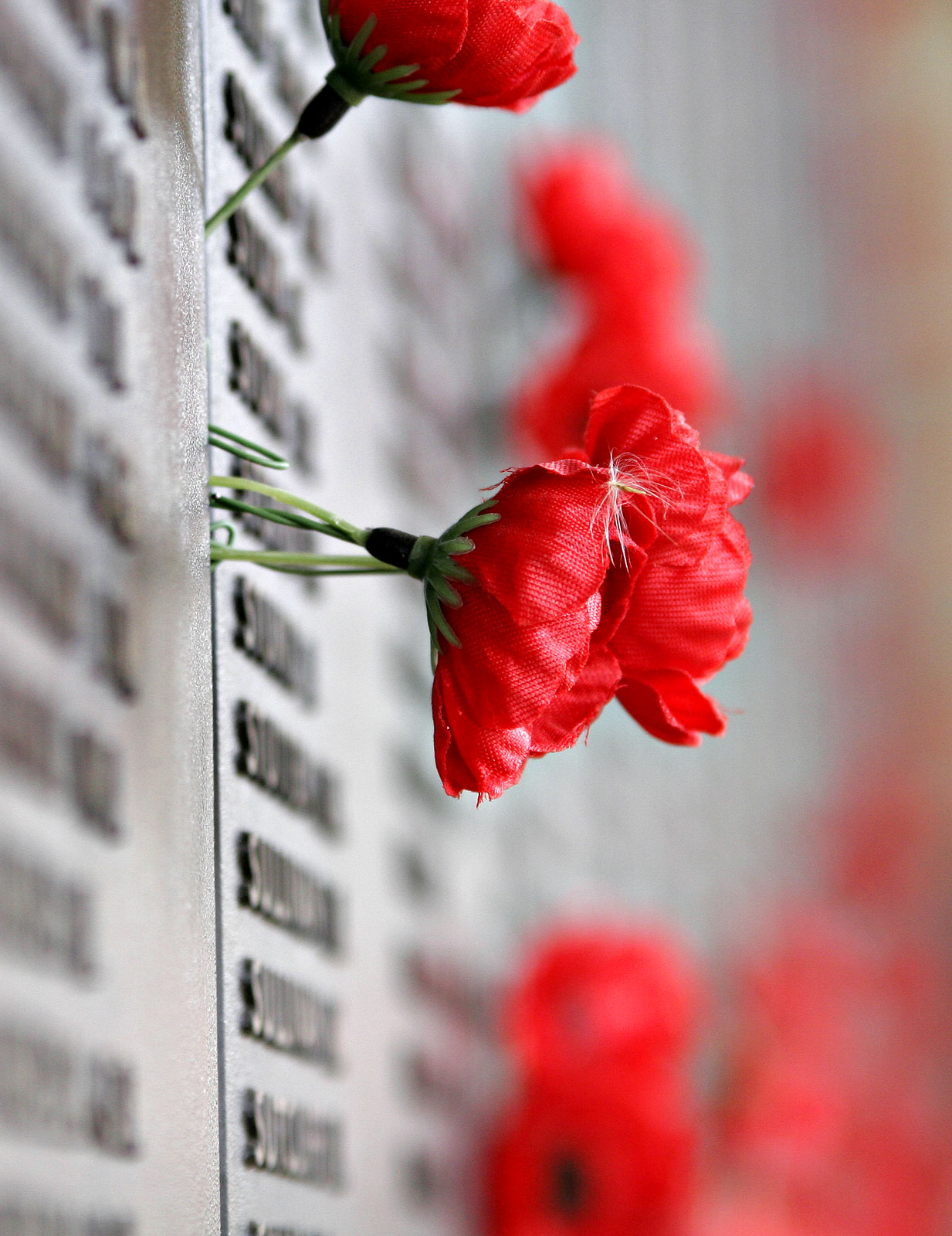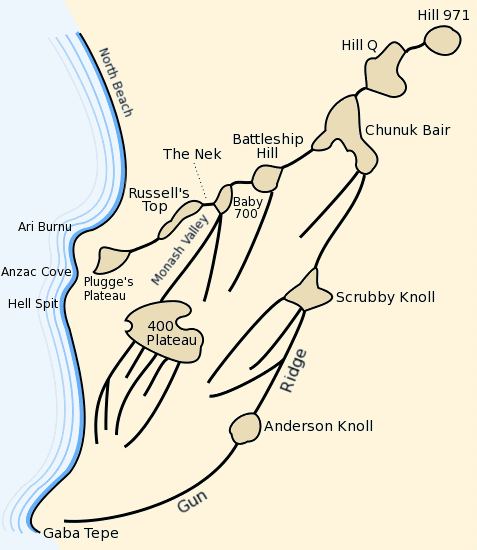|
ANZAC
The Australian and New Zealand Army Corps (ANZAC) was originally a First World War army corps of the British Empire under the command of the Mediterranean Expeditionary Force. It was formed in Egypt in December 1914, and operated during the Gallipoli campaign. General William Birdwood commanded the corps, which primarily consisted of troops from the First Australian Imperial Force and 1st New Zealand Expeditionary Force, although there were also British and Indian units attached at times throughout the campaign. The corps disbanded in 1916, following the Allied evacuation of the Gallipoli peninsula and the formation of I ANZAC Corps and II ANZAC Corps. The corps was re-established, briefly, in the Second World War during the Battle of Greece in 1941. The term 'ANZAC' has been used since for joint Australian–New Zealand units of different sizes. History Original formation and the Gallipoli disaster Plans for the formation began in November 1914 while the first conti ... [...More Info...] [...Related Items...] OR: [Wikipedia] [Google] [Baidu] |
Anzac Day
Anzac Day is a national day of remembrance in Australia, New Zealand and Tonga that broadly commemorates all Australians and New Zealanders "who served and died in all wars, conflicts, and peacekeeping operations" and "the contribution and suffering of all those who have served". Observed on 25 April each year, Anzac Day was originally devised to honour the members of the Australian and New Zealand Army Corps (ANZAC) who served in the Gallipoli campaign, their first engagement in the First World War (1914–1918). History Anzac Day marks the anniversary of the first campaign that led to major casualties for Australian and New Zealand forces during the First World War. The acronym ANZAC stands for Australian and New Zealand Army Corps, whose soldiers were known as Anzacs. Anzac Day remains one of the most important national occasions of both Australia and New Zealand; however, the ceremonies and their meanings have changed significantly since 1915. According to Martin Crotty ... [...More Info...] [...Related Items...] OR: [Wikipedia] [Google] [Baidu] |
I ANZAC Corps
The I ANZAC Corps (First Anzac Corps) was a combined Australian and New Zealand army corps that served during World War I. It was formed in Egypt in February 1916 as part of the reorganisation and expansion of the Australian Imperial Force and the New Zealand Expeditionary Force (NZEF) following the evacuation of Gallipoli in December 1915. Along with the II ANZAC Corps, it replaced the original Australian and New Zealand Army Corps (ANZAC). The corps initially participated in the defence of the Suez Canal before being transferred to the Western Front in France and Belgium in late March 1916. Later in 1916 the New Zealand Division was removed from I ANZAC's order of battle, swapping with II ANZAC's Australian 4th Division. In November 1917, I ANZAC ceased to exist when the Australian infantry divisions in France were grouped together as the Australian Corps and the New Zealand Division, then part of II ANZAC Corps, was allocated to a British corps. History Formation Foll ... [...More Info...] [...Related Items...] OR: [Wikipedia] [Google] [Baidu] |
First Australian Imperial Force
The First Australian Imperial Force (1st AIF) was the main Expeditionary warfare, expeditionary force of the Australian Army during the First World War. It was formed as the Australian Imperial Force (AIF) following United Kingdom of Great Britain and Ireland, Britain's declaration of war on German Empire, Germany on 15 August 1914, with an initial strength of one infantry division (military), division and one Australian light horse, light horse brigade. The infantry division subsequently fought at Gallipoli Campaign, Gallipoli between April and December 1915, with a newly raised second division, as well as three light horse brigades, reinforcing the committed units. After being evacuated to Egypt, the AIF was expanded to five infantry divisions, which were committed to the fighting in France and Belgium along the Western Front (World War I), Western Front in March 1916. A sixth infantry division was partially raised in 1917 in the United Kingdom, but was broken up and used as ... [...More Info...] [...Related Items...] OR: [Wikipedia] [Google] [Baidu] |
William Birdwood
Field marshal (United Kingdom), Field Marshal William Riddell Birdwood, 1st Baron Birdwood (13 September 1865 – 17 May 1951), was a British Army officer. He saw active service in the Second Boer War on the staff of Herbert Kitchener, 1st Earl Kitchener, Lord Kitchener. He saw action again in the First World War as commander of the Australian and New Zealand Army Corps during the Gallipoli Campaign in 1915, leading the landings on the peninsula and then the evacuation later in the year, before becoming commander-in-chief of the Fifth Army (United Kingdom), Fifth Army on the Western Front (World War I), Western Front during the closing stages of the war. He went on to be general officer commanding the Northern Command (India), Northern Army in India in 1920 and Commander-in-Chief, India, in 1925. Early life William Riddell Birdwood was born on 13 September 1865 in Khadki, Kirkee, India. His father, Herbert Mills Birdwood, born in Bombay and educated in the UK, had returned to Ind ... [...More Info...] [...Related Items...] OR: [Wikipedia] [Google] [Baidu] |
II ANZAC Corps
The II ANZAC Corps (Second Anzac Corps) was an Australian and New Zealand First World War army corps. Formed in early 1916 in Egypt in the wake of the failed Gallipoli campaign, it initially consisted of two Australian divisions, and was sent to the Western Front in mid-1916. It then took part in the fighting in France and Belgium throughout 1916 and 1917, during which time it consisted of New Zealand, Australian and British divisions. In November 1917, the corps was subsumed in to the Australian Corps, which concentrated all five Australian infantry divisions. After this, the corps was reformed as the British XXII Corps. History The corps was formed in Egypt in February 1916 as part of the reorganization of the Australian Imperial Force following the evacuation of Gallipoli in December 1915, under the command of William Birdwood. This corps, along with the I ANZAC Corps, replaced the original Australian and New Zealand Army Corps (ANZAC), following the expansion of the Aus ... [...More Info...] [...Related Items...] OR: [Wikipedia] [Google] [Baidu] |
New Zealand Mounted Rifles Brigade
The New Zealand Mounted Rifles Brigade was a brigade of the New Zealand Army during the First World War. Raised in 1914 as part of the New Zealand Expeditionary Force, it was one of the first New Zealand units to sail for service overseas. The brigade was formed from three regiments – the Auckland Mounted Rifles, the Canterbury Mounted Rifles, the Wellington Mounted Rifles – and smaller support units. Altogether the brigade had an establishment of 1,940 men and 2,032 horses and by the end of the war over 17,700 men had served in the brigade. However, the entire brigade's dismounted rifle strength was the equivalent of only a battalion of infantry. By the end of 1914, the brigade had arrived in British Egypt and was assigned to the New Zealand and Australian Division. Its first active service was, in a dismounted role, during the Gallipoli Campaign, where they fought against the forces of the Ottoman Turkish Empire. Seven months later, after the evacuation from Gall ... [...More Info...] [...Related Items...] OR: [Wikipedia] [Google] [Baidu] |
New Zealand Infantry Brigade
The New Zealand and Australian Division was a composite army division raised for service in the First World War under the command of Major General Alexander Godley. Consisting of several mounted and standard infantry brigades from both New Zealand and Australia, it served in the Gallipoli Campaign between April and December 1915. At Gallipoli, the division landed at Anzac Cove on 25 April 1915, coming ashore as follow-on troops to the initial assault force that had made it ashore earlier in the day, and later occupied the northern areas of the Allied lodgement. After the initial Allied assault at Anzac Cove, elements of the division were sent to Cape Helles in early May, where they participated in the Second Battle of Krithia, launching an unsuccessful attack towards the Achi Baba peak. The division's mounted units were sent to Gallipoli in mid-May without their horses, to serve as dismounted infantry, making up for previous losses. Later that month, the division helped rep ... [...More Info...] [...Related Items...] OR: [Wikipedia] [Google] [Baidu] |
New Zealand And Australian Division
The New Zealand and Australian Division was a composite army Division (military), division raised for service in the First World War under the command of Major General Alexander Godley. Consisting of several Mounted infantry, mounted and standard infantry brigades from both New Zealand and Australia, it served in the Gallipoli Campaign between April and December 1915. At Gallipoli, the division Landing at Anzac Cove, landed at Anzac Cove on 25 April 1915, coming ashore as follow-on troops to the initial assault force that had made it ashore earlier in the day, and later occupied the northern areas of the Allies of World War I, Allied lodgement. After the initial Allied assault at Anzac Cove, elements of the division were sent to Cape Helles in early May, where they participated in the Second Battle of Krithia, launching an unsuccessful attack towards the Achi Baba peak. The division's mounted units were sent to Gallipoli in mid-May without their horses, to serve as dismounted infa ... [...More Info...] [...Related Items...] OR: [Wikipedia] [Google] [Baidu] |
1st New Zealand Expeditionary Force
The New Zealand Expeditionary Force (NZEF) was the title of the military forces sent from New Zealand to fight alongside other British Empire and Dominion troops during World War I (1914–1918) and World War II (1939–1945). Ultimately, the NZEF of World War I became known as the ''First New Zealand Expeditionary Force''. The NZEF of World War II was known as the ''Second New Zealand Expeditionary Force'' (2NZEF). The 2NZEF was led by General Bernard Freyberg. 1st New Zealand Expeditionary Force The New Zealand Expeditionary Force (NZEF) was the title of the military forces sent from New Zealand to fight for Britain during World War I. Upon the outbreak of war, New Zealand immediately offered to provide two brigades—one of infantry and one of mounted troops—with a total of 8,500 men. As was the case with the Australian army the existing New Zealand army was a "territorial" force, designed for the defense of the home islands. It could not be deployed overseas. Hence, it ... [...More Info...] [...Related Items...] OR: [Wikipedia] [Google] [Baidu] |
First World War
World War I or the First World War (28 July 1914 – 11 November 1918), also known as the Great War, was a World war, global conflict between two coalitions: the Allies of World War I, Allies (or Entente) and the Central Powers. Fighting took place mainly in European theatre of World War I, Europe and the Middle Eastern theatre of World War I, Middle East, as well as in parts of African theatre of World War I, Africa and the Asian and Pacific theatre of World War I, Asia-Pacific, and in Europe was characterised by trench warfare; the widespread use of Artillery of World War I, artillery, machine guns, and Chemical weapons in World War I, chemical weapons (gas); and the introductions of Tanks in World War I, tanks and Aviation in World War I, aircraft. World War I was one of the List of wars by death toll, deadliest conflicts in history, resulting in an estimated World War I casualties, 10 million military dead and more than 20 million wounded, plus some 10 million civilian de ... [...More Info...] [...Related Items...] OR: [Wikipedia] [Google] [Baidu] |
Gallipoli Peninsula
The Gallipoli Peninsula (; ; ) is located in the southern part of East Thrace, the European part of Turkey, with the Aegean Sea to the west and the Dardanelles strait to the east. Gallipoli is the Italian form of the Greek name (), meaning 'beautiful city', the original name of the modern town of Gelibolu. In antiquity, the peninsula was known as the Thracian Chersonese (; ). The peninsula runs in a south-westerly direction into the Aegean Sea, between the Dardanelles (formerly known as the Hellespont), and the Gulf of Saros (formerly the bay of Melas). In antiquity, it was protected by the Long Wall, a defensive structure built across the narrowest part of the peninsula near the ancient city of Agora. The isthmus traversed by the wall was only 36 stadia in breadthHerodotus, ''The Histories''vi. 36 Xenophon, ibid.; Pseudo-Scylax, '' Periplus of Pseudo-Scylax'', 67PDF) or about , but the length of the peninsula from this wall to its southern extremity, Cape Mastusia, was ... [...More Info...] [...Related Items...] OR: [Wikipedia] [Google] [Baidu] |
1st Division (Australia)
The 1st Division, also known as the 1st (Australian) Division, is a division headquartered in Enoggera Barracks in Brisbane. The division was first formed in 1914 for service during the First World War as a part of the Australian Imperial Force (AIF). It was initially part of the Australian and New Zealand Army Corps (ANZAC) and served with that formation during the Gallipoli campaign, before later serving on the Western Front. After the war, the division became a part-time unit based in New South Wales. During the Second World War it undertook defensive duties in Australia. It was disbanded in 1945. After the Second World War, the division remained off the Australian Army's order of battle until the 1960s, when it was reformed in New South Wales. In 1965 it adopted a certification role, determining the operational readiness of units deploying to Vietnam. It was re-formed in 1973 as a full division based in Queensland and in the decades that followed it formed the Australia ... [...More Info...] [...Related Items...] OR: [Wikipedia] [Google] [Baidu] |









